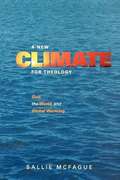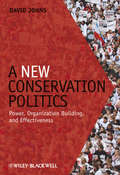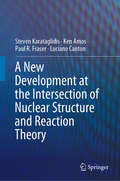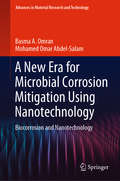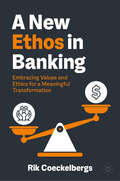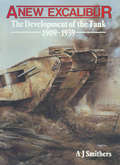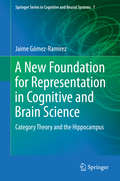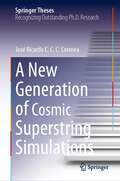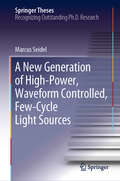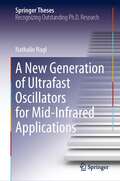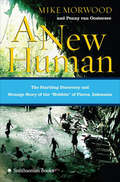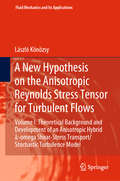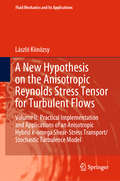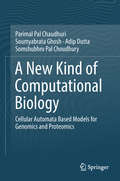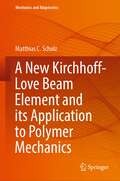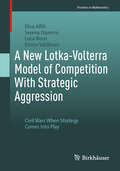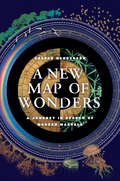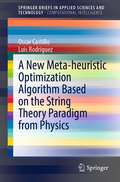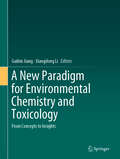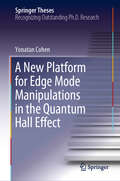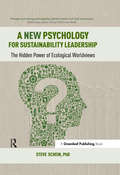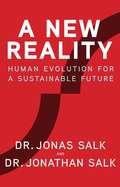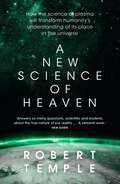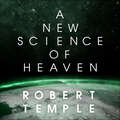- Table View
- List View
A New Climate For Theology: God, The World, And Global Warming
by Sallie McFagueClimate change promises monumental changes to human and other planetary life in the next generations. Yet government, business, and individuals have been largely in denial of the possibility that global warming may put our species on the road to extinction. Further, says Sallie McFague, we have failed to see the real root of our behavioral troubles in an economic model that actually reflects distorted religious views of the person. At its heart, she maintains, global warming occurs because we lack an appropriate understanding of ourselves as inextricably bound to the planet and its systems. A New Climate for Theology not only traces the distorted notion of unlimited desire that fuels our market system; it also paints an alternative idea of what being human means and what a just and sustainable economy might mean. Convincing, specific, and wise, McFague argues for an alternative economic order and for our relational identity as part of an unfolding universe that expresses divine love and human freedom. It is a view that can inspire real change, an altered lifestyle, and a form of Christian discipleship and desire appropriate to who we really are. Table of Contents Preface Part One: The Science and its Significance for Theology Chapter 1: Climate Change: The Evidence and Consequences Chapter 2: Global Warming: A Theological Problem Part Two: Exploring God and the World within Climate Change Chapter 3: Who Are We? Ecological Anthropology Chapter 4: Who Is God? Creation and Providence Chapter 5: How Shall We Live? Christianity and Planetary Economics Part Three: Serving God and City Living within Climate Change Chapter 6: Why We Worship: Praise and Compassion as Intimations of Transcendence Chapter 7: Where We Live: Urban Ecotheology Part Four: Despair and Hope within Climate Change Chapter 8: Is a Different World Possible? Human Dignity and the Integrity of Creation in a Time of Global Warming Chapter 9: ?The Dearest Freshness Deep Down Things: The Holy Spirit and Climate Change Notes
A New Conservation Politics: Power, Organization Building and Effectiveness
by David JohnsDespite many successes in the field of conservation, species extinction rates continue to climb and wild areas and habitats continue to be lost. Many look to more (or better) biology and ecology to solve the problem but the obstacles are not just scientific but political. To stop the 6th great extinction the conservation movement must become much stronger, more tenacious, and more effective. By learning from its own history and especially from the movements that abolished slavery, brought down apartheid, changed gender relations, and expanded democratic rights, conservationists can become more successful. This book brings together in one place and in a highly usable format the lessons of those movements culled from practitioners and academic analysts. "Protecting Earth's rich web of life, and our only known living companions in the universe, depends upon people caring enough to act. This book shows conservationists how to evoke the caring and action necessary to change policy and ultimately society." Paul R Ehrlich, Bing Professor of Population Studies, Stanford University and author of The Dominant Animal: Human Evolution and the Environment “This timely book by David Johns explains why facts alone don’t motivate and mobilize people to care for the natural world. Even better, Johns spells out what will work, based on a frank and informed assessment of human nature applied to social and political movements. If you would rather see change than be right, this readable and authoritative guide should be your bible.” Michael Soulé, Professor Emeritus, Environmental Studies, University of California, Santa Cruz “For me, this is a truly fascinating book. I spend much of my time writing--trying to write the stories we need to tell--and the rest of it helping run national and global mobilizations on climate change (Step It Up and now 350.org). I think David Johns has done a tremendous job of linking together insights about useful rhetoric and very practical notions about organizing. If you're trying to save a river, a forest, or a planet you need to read this book.” Bill McKibben, Scholar-in-Residence, Middlebury College
A New Development at the Intersection of Nuclear Structure and Reaction Theory
by Steven Karataglidis Ken Amos Paul R. Fraser Luciano CantonThis book highlights a major advance in low-energy scattering theory: the Multi-Channel Algebraic Scattering (MCAS) theory, which represents an attempt to unify structure and reaction theory. It solves the Lippmann–Schwinger equations for low-energy nucleon-nucleus and alpha-nucleus scattering in momentum space, allowing both the bound and scattering states in the compound nucleus formed to be described. Results of various cases are presented and discussed.
A New Era for Microbial Corrosion Mitigation Using Nanotechnology: Biocorrosion and Nanotechnology (Advances in Material Research and Technology)
by Basma A. Omran Mohamed Omar Abdel-SalamThis book focuses on corrosion and microbial corrosion, providing solutions for these problems based on nanotechnology and nanobiotechnology. It introduces the causes, consequences, cost and control of corrosion processes. It gives a particular emphasis on microbial corrosion of steel and other metals in oil, gas and shipping industries. The book presents the materials vulnerable to such kind of corrosion, and the use of nanomaterials to control it.
A New Ethos in Banking: Embracing Values and Ethics for a Meaningful Transformation
by Rik CoeckelbergsThe financial services industry has one constant lately - change. What are the lessons of the past 25 years, and what can be done better in the future, especially when it comes to digital transformation and sustainability? This book investigates how change is impacting banking and the industry’s reputation, exploring what a new ethos in banking should look like, and, more importantly, the needed contributions from the industry to the road ahead. Based on interviews with industry leaders and the author's own personal experience, this book guides decision-makers in a new direction, a positive alternative to the status quo. The book is an urgent call to action, with practical and relevant insights to improve a bank’s societal footprint beyond the required compliance and regulatory efforts into sustainability, transparency, and ethics in banking. It will inspire those that look for successful stakeholder models without ignoring shareholder interests, putting people and society first, and understanding this can only work with a healthy financial model.
A New Excalibur: The Development of the Tank 1909–1939
by A. J. SmithersThe story of the inventors, engineers, soldiers, and politicians behind the emergence of the armored fighting vehicle. The birth and infancy of the tank had an enormous number of technical problems to be solved—but the issues with its construction paled in comparison to the endless squabbles among the people involved. This fascinating study of the vehicle which was born out of the stalemate of the Western Front in the First World War looks at all the obstacles that had to be overcome. As is inevitable in almost any work of history set in the first half of the century, the figure of Winston Churchill looms large—but the role that he played in this instance is remarkable even by his standard, when it is remembered that at the crucial time he was First Lord of the Admiralty and theoretically had nothing to do with warfare on land. Foremost among the leading actors in the drama are Sir Eustace Tennyson-d&’Eyncourt, Sir Ernest Swinton, Bertie Stern, Sir William Tritton, and Walter Gordon Wilson. This is the first exhaustive study of the men behind the earliest tanks. The story of their furious quarrels and the machines they produced combine to make a remarkable and compelling study.
A New Foundation for Representation in Cognitive and Brain Science: Category Theory and the Hippocampus (Springer Series in Cognitive and Neural Systems #7)
by Jaime Gómez-RamirezThe purpose of the book is to advance in the understanding of brain function by defining a general framework for representation based on category theory. The idea is to bring this mathematical formalism into the domain of neural representation of physical spaces, setting the basis for a theory of mental representation, able to relate empirical findings, uniting them into a sound theoretical corpus. The innovative approach presented in the book provides a horizon of interdisciplinary collaboration that aims to set up a common agenda that synthesizes mathematical formalization and empirical procedures in a systemic way. Category theory has been successfully applied to qualitative analysis, mainly in theoretical computer science to deal with programming language semantics. Nevertheless, the potential of category theoretic tools for quantitative analysis of networks has not been tackled so far. Statistical methods to investigate graph structure typically rely on network parameters. Category theory can be seen as an abstraction of graph theory. Thus, new categorical properties can be added into network analysis and graph theoretic constructs can be accordingly extended in more fundamental basis. By generalizing networks using category theory we can address questions and elaborate answers in a more fundamental way without waiving graph theoretic tools. The vital issue is to establish a new framework for quantitative analysis of networks using the theory of categories, in which computational neuroscientists and network theorists may tackle in more efficient ways the dynamics of brain cognitive networks. The intended audience of the book is researchers who wish to explore the validity of mathematical principles in the understanding of cognitive systems. All the actors in cognitive science: philosophers, engineers, neurobiologists, cognitive psychologists, computer scientists etc. are akin to discover along its pages new unforeseen connections through the development of concepts and formal theories described in the book. Practitioners of both pure and applied mathematics e. g. , network theorists, will be delighted with the mapping of abstract mathematical concepts in the terra incognita of cognition.
A New Generation of Cosmic Superstring Simulations (Springer Theses)
by José Ricardo CorreiraTopological defects are an expected consequence of phase transitions in the early Universe. As such these objects, if detected, provide unequivocal evidence of physics beyond the Standard Model. This means they are prime targets for new observational facilities. However, our understanding of defects is heavily bottlenecked by computational limitations. In this book, the author explores the use of accelerator hardware to alleviate this problem, presenting the world’s first (multiple-)GPU defect simulations. Such simulations can evolve a network of line-like cosmic strings at an unprecedented resolution. Then these are used to obtain the most accurate to date calibrations of semi-analytical modelling and to show the impact of accuracy on observational consequences of strings. Lastly, a modified version of this application is used to study interconnected networks of strings in greater detail than ever before. This book benefits any student or researcher who wishes to learn about field theory simulations in the early Universe and about supercomputing with multiple accelerators.
A New Generation of High-Power, Waveform Controlled, Few-Cycle Light Sources (Springer Theses)
by Marcus SeidelThis thesis presents first successful experiments to carrier-envelope-phase stabilize a high-power mode-locked thin-disk oscillator and to compress the pulses emitted from this laser to durations of only a few-optical cycles. Moreover, the monograph introduces several methods to achieve power-scalability of compression and stabilization techniques. All experimental approaches are compared in detail and may serve as a guideline for developing high-power waveform controlled, few-cycle light sources which offer tremendous potential to exploit extreme nonlinear optical effects at unprecedentedly high repetition rates and to establish table-top infrared light sources with a unique combination of brilliance and bandwidth. As an example, the realization of a multi-Watt, multi-octave spanning, mid-infrared femtosecond source is described. The thesis starts with a basic introduction to the field of ultrafast laser oscillators. It subsequently presents additional details of previously published research results and establishes a connection between them. It therefore addresses both newcomers to, and experts in the field of high-power ultrafast laser development.
A New Generation of Ultrafast Oscillators for Mid-Infrared Applications (Springer Theses)
by Nathalie NaglThis thesis presents the first successful realization of a compact, low-noise, and few-cycle light source in the mid-infrared wavelength region. By developing the technology of pumping femtosecond chromium-doped II-VI laser oscillators directly with the emission of broad-stripe single-emitter laser diodes, coherent light was generated with exceptionally low amplitude noise — crucial for numerous applications including spectroscopy at high sensitivities. Other key parameters of the oscillator's output, such as pulse duration and output power, matched and even surpassed previous state-of-the-art systems. As a demonstration of its unique capabilities, the oscillator's powerful output was used to drive — without further amplification — the nonlinear generation of coherent mid-infrared light spanning multiple octaves. The resulting table-top system uniquely combines high brilliance and ultrabroad spectral bandwidth in the important mid-infrared spectral range. The rapid development of this technology is comprehensively and lucidly documented in this PhD thesis. Together with a thorough review of literature and applications, and an extensive analysis of the theoretical foundations behind ultrafast laser oscillators, the thesis will serve as a valuable reference for the construction of a new generation of mid-infrared light sources.
A New Human: The Startling Discovery and Strange Story of the "Hobbits" of Flores, Indonesia
by Mike Morwood Penny Van OosterzeeIn October 2004, a team of Australian and Indonesian anthropologists led by Mike Morwood and Raden Pandji Soejono stunned the world with their announcement of the discovery of the first example of a new species of human, Homo floresiensis, which they nicknamed the "Hobbit." This was no creation of Tolkien's fantasy, however, but a tool-using, fire-making, cooperatively hunting person. The more Morwood and his colleagues revealed about the find, the more astonishing it became: standing only three feet tall with brains a little larger than a can of cola, the Hobbits forced anthropologists and everyone to reconsider what it means to be human.Morwood's work was no ordinary academic exercise. Along the way he had to tread warily through the cultural landscape of Indonesia—he has an embarrassing mishap with some hard-to-chew pork—and he demonstrated that sometimes the life of a real archaeologist can be a bit like Indiana Jones's when he risked his neck in an ocean-going raft to experience how ancient Indonesians might have navigated the archipelago. Even more, Morwood had to navigate the rock shoals of an archaeological bureaucracy that could be obtuse and even spiteful, and when the Hobbits became embroiled in scientific controversy—as no find of such magnitude could avoid—it proved easy for Morwood to get nearly swamped with trouble. Finds were stolen and damaged, and the backbiting was fierce. But the light of science, once brightened, is difficult to dim, and the story of the indefatigable Morwood's fight to defend his find discovery is an inspiration.
A New Hypothesis on the Anisotropic Reynolds Stress Tensor for Turbulent Flows: Volume I: Theoretical Background and Development of an Anisotropic Hybrid k-omega Shear-Stress Transport/Stochastic Turbulence Model (Fluid Mechanics and Its Applications #120)
by László KönözsyThis book gives a mathematical insight--including intermediate derivation steps--into engineering physics and turbulence modeling related to an anisotropic modification to the Boussinesq hypothesis (deformation theory) coupled with the similarity theory of velocity fluctuations. Through mathematical derivations and their explanations, the reader will be able to understand new theoretical concepts quickly, including how to put a new hypothesis on the anisotropic Reynolds stress tensor into engineering practice. The anisotropic modification to the eddy viscosity hypothesis is in the center of research interest, however, the unification of the deformation theory and the anisotropic similarity theory of turbulent velocity fluctuations is still missing from the literature. This book brings a mathematically challenging subject closer to graduate students and researchers who are developing the next generation of anisotropic turbulence models. Indispensable for graduate students, researchers and scientists in fluid mechanics and mechanical engineering.
A New Hypothesis on the Anisotropic Reynolds Stress Tensor for Turbulent Flows: Volume II: Practical Implementation and Applications of an Anisotropic Hybrid k-omega Shear-Stress Transport/Stochastic Turbulence Model (Fluid Mechanics and Its Applications #125)
by László KönözsyThis self-contained, interdisciplinary book encompasses mathematics, physics, computer programming, analytical solutions and numerical modelling, industrial computational fluid dynamics (CFD), academic benchmark problems and engineering applications in conjunction with the research field of anisotropic turbulence. It focuses on theoretical approaches, computational examples and numerical simulations to demonstrate the strength of a new hypothesis and anisotropic turbulence modelling approach for academic benchmark problems and industrially relevant engineering applications. This book contains MATLAB codes, and C programming language based User-Defined Function (UDF) codes which can be compiled in the ANSYS-FLUENT environment. The computer codes help to understand and use efficiently a new concept which can also be implemented in any other software packages. The simulation results are compared to classical analytical solutions and experimental data taken from the literature. A particular attention is paid to how to obtain accurate results within a reasonable computational time for wide range of benchmark problems. The provided examples and programming techniques help graduate and postgraduate students, engineers and researchers to further develop their technical skills and knowledge.
A New Kind of Computational Biology: Cellular Automata Based Models for Genomics and Proteomics
by Parimal Pal Chaudhuri Soumyabrata Ghosh Adip Dutta Somshubhro Pal ChoudhuryThis book reflects more than three decades of research on Cellular Automata (CA), and nearly a decade of work on the application of CA to model biological strings, which forms the foundation of 'A New Kind of Computational Biology' pioneered by the start-up, CARLBio. After a brief introduction on Cellular Automata (CA) theory and functional biology, it reports on the modeling of basic biological strings with CA, starting with the basic nucleotides leading to codon and anti-codon CA models. It derives a more involved CA model of DNA, RNA, the entire translation process for amino acid formation and the evolution of protein to its unique structure and function. In subsequent chapters the interaction of Proteins with other bio-molecules is also modeled. The only prior knowledge assumed necessary is an undergraduate knowledge of computer programming and biology. The book adopts a hands-on, “do-it-yourself” approach to enable readers to apply the method provided to derive the CA rules and comprehend how these are related to the physical ‘rules’ observed in biology. In a single framework, the authors have presented two branches of science – Computation and Biology. Instead of rigorous molecular dynamics modeling, which the authors describe as a Bottoms-Up model, or relying on the Top-Down new age Artificial Intelligence (AI) and Machine Language (ML) that depends on extensive availability of quality data, this book takes the best from both the Top-Down and Bottoms-up approaches and establishes how the behavior of complex molecules is represented in CA. The CA rules are derived from the basic knowledge of molecular interaction and construction observed in biological world but mapped to a few subset of known results to derive and predict results.This book is useful for students, researchers and industry practitioners who want to explore modeling and simulation of the physical world complex systems from a different perspective. It raises the inevitable the question – ‘Are life and the universe nothing but a collection of continuous systems processing information’.
A New Kirchhoff-Love Beam Element and its Application to Polymer Mechanics (Mechanics and Adaptronics)
by Matthias C. SchulzThe novel finite element formulations fall into the category of geometrically exact Kirchhoff-Love beams. A prominent characteristic of this category is that the absence of shear deformation is strongly enforced by removing two degrees of freedom. Further, the corresponding beam theories exhibit not only translational but also rotational degrees of freedom and their configurations thus form a non-additive and non-commutative space. Sophisticated interpolation schemes are required that need to be tested not only for locking, spatial convergence behavior, and energy conservation, but also for observer invariance and path-independence. For the three novel beam element formulations all these properties are analytically and numerically studied and confirmed, if applicable. Two different rotation parameterization strategies are employed based on the well-known geodesic interpolation used in many Simo-Reissner beams and the lesser known split into the so-called \textit{smallest rotation} and a torsional part. Application of the former parameterization results in a mixed finite element formulation intrinsically free of locking phenomena. Additionally, the first geometrically exact Kirchhoff-Love beam element is presented, which strongly enforces inextensibility by removing another degree of freedom. Furthermore, the numerical efficiency of the new beam formulations is compared to other beam elements that allow for or suppress shear deformation. When modeling very slender beams, the new elements offer distinct numerical advantages.Standard molecular dynamics simulations, which are commonly used to study polymers, suffer from a lack of a careful mathematical basis and the use of an expensive explicit time integration scheme. To circumvent these shortcomings and to be able to simulate stretching experiments on relevant time scales, the problem is described by a stochastic partial differential equation, which can be solved using the finite element method with a backward Euler temporal discretization. In detail, the polymer is represented by a Kirchhoff-Love beam with a linear elastic constitutive model. Inertial and electrostatic forces are neglected. It is deformed by a distributed load mimicking collisions with molecules of the surrounding fluid. Naturally, this load heavily fluctuates over time and space and mean values need to be computed in a Monte Carlo manner. To vastly speed up the fitting process to experimental data in a Bayesian framework, a surrogate model based on a Gaussian process is set up, which directly computes the mean values for given material parameters. The uncertainties and correlations of the material parameters are studied and compared to the literature.
A New Lotka-Volterra Model of Competition With Strategic Aggression: Civil Wars When Strategy Comes Into Play (Frontiers in Mathematics)
by Luca Rossi Enrico Valdinoci Serena Dipierro Elisa AffiliThis monograph introduces a new mathematical model in population dynamics that describes two species sharing the same environmental resources in a situation of open hostility. Its main feature is the expansion of the family of Lotka-Volterra systems by introducing a new term that defines aggression. Because the model is flexible, it can be applied to various scenarios in the context of human populations, such as strategy games, competition in the marketplace, and civil wars. Drawing from a variety of methodologies within dynamical systems, ODEs, and mathematical biology, the authors' approach focuses on the dynamical properties of the system. This is accomplished by detecting and describing all possible equilibria, and analyzing the strategies that may lead to the victory of the aggressive population. Techniques typical of two-dimensional dynamical systems are used, such as asymptotic behaviors regulated by the Poincaré–Bendixson Theorem. A New Lotka-Volterra Model of Competition With Strategic Aggression will appeal to researchers and students studying population dynamics and dynamical systems, particularly those interested in the cross section between mathematics and ecology.
A New Map of Wonders: A Journey in Search of Modern Marvels
by Caspar Henderson“Henderson teaches us how to wonder anew with a new vision of science illuminated by a rich range of literature, philosophy, art, and music.” —Hugh Aldersey-Williams, author of Dutch LightWe live in a world that is known, every corner thoroughly explored. But has this knowledge cost us the ability to wonder? Wonder, Caspar Henderson argues, is at its most supremely valuable in just such a world because it reaffirms our humanity and gives us hope for the future. That’s the power of wonder, and that’s what we should aim to cultivate in our lives. But what are the wonders of the modern world?Henderson’s brilliant exploration borrows from the form of one of the oldest and most widely known sources of wonder: maps. Large, detailed mappae mundi invited people in medieval Europe to vividly imagine places and possibilities they had never seen before: manticores with the head of a man, the body of a lion, and the stinging tail of a scorpion; tribes of one-eyed men who fought griffins for diamonds; and fearsome Scythian warriors who drank the blood of their enemies from their skulls. A New Map of Wonders explores these and other realms of the wonderful, in different times and cultures and in the present day, taking readers from Aboriginal Australian landscapes to sacred sites in Great Britain, all the while keeping sight questions such as the cognitive basis of wonder and the relationship between wonder and science.Beautifully illustrated and written with wit and moral complexity, this sequel to The Book of Barely Imagined Beings is a fascinating account of the power of wonder and an unforgettable meditation on its importance to our future.
A New Meta-heuristic Optimization Algorithm Based on the String Theory Paradigm from Physics (SpringerBriefs in Applied Sciences and Technology)
by Luis Rodriguez Oscar CastilloThis book focuses on the fields of nature-inspired algorithms, optimization problems and fuzzy logic. In this book, a new metaheuristic based on String Theory from Physics is proposed. It is important to mention that we have proposed the new algorithm to generate new potential solutions in optimization problems in order to find new ways that could improve the results in solving these problems. We are presenting the results for the proposed method in different cases of study. The first case, is optimization of traditional benchmark mathematical functions. The second case, is the optimization of benchmark functions of the CEC 2015 Competition and we are also presenting results of the CEC 2017 Competition on Constrained Real-Parameter Optimization that are problems that contain the presence of constraints that alter the shape of the search space making them more difficult to solve. Finally, in the third case, we are presenting the optimization of a fuzzy inference system, specifically for finding the optimal design of a fuzzy controller for an autonomous mobile robot. It is important to mention that in all study cases we are presenting statistical tests in or-der to validate the performance of proposed method. In summary, we believe that this book will be of great interest to a wide audience, ranging from engineering and science graduate students, to researchers and professors in computational intelligence, metaheuristics, optimization, robotics and control.
A New Paradigm for Environmental Chemistry and Toxicology: From Concepts to Insights
by Guibin Jiang Xiangdong LiThis book provides comprehensive coverage of the theoretical developments and technological breakthroughs that have deepened our understanding of environmental pollution and human health, while also promoting a comprehensive strategy to address these problems. The respective chapters highlight groundbreaking concepts fueling the development of environmental chemistry and toxicology; revolutionary analytical and computational approaches providing novel insights into environmental health; and nature-inspired, innovative engineering solutions for tackling complex hazardous exposures. The book also features a forward-looking perspective on emerging environmental issues that call for new research and regulatory paradigms, laying the groundwork for future advances in the broad field of environmental chemistry and toxicology. Written by respected authorities in the field, A New Paradigm for Environmental Chemistry and Toxicology - From Concepts to Insights will offer an invaluable reference guide for concerned researchers and professional practitioners for years to come.
A New Platform for Edge Mode Manipulations in the Quantum Hall Effect (Springer Theses)
by Yonatan CohenIn the last several decades, the quantum Hall effect has provided a remarkable platform for manipulating one-dimensional electronic modes and investigating fundamental physical phenomena. However, certain limitations make it difficult for various kinds of interesting modes structures to be formed using this platform. One example is the so called helical mode structure, in which two one-dimensional, counter propagating modes have opposite spins and thus spin and momentum are locked. Such helical modes have lately attracted significant interest, since, when coupled to a conventional superconductor, they are expected to manifest topological superconductivity and host Majorana zero modes. Even more interesting are fractional helical modes, which open the way for realizing generalized parafermionic zero modes. Possessing non-abelian exchange statistics, these quasiparticles may serve as building blocks in topological quantum computing. Here we present a new platform for manipulating integer and fractional quantum Hall edge modes, which allows the formation of robust one-dimensional helical as well as fractional helical modes. The platform is based on a carefully designed double-quantum-well structure in a GaAs based system hosting two electronic sub-bands in the quantum Hall effect regime. By electrostatic gating of different areas of the structure, counter-propagating integer, as well as fractional, edge modes with opposite spins are formed and their spin protection is verified. Beyond the formation of helical modes, the new platform can serve as a rich playground for new research. Some new possibilities include the artificial induction of compounded fractional edge modes and the construction of new edge mode-based interferometers.
A New Psychology for Sustainability Leadership: The Hidden Power of Ecological Worldviews
by Steve ScheinDuring the last decade, the sustainability position in multinational corporations has grown in influence. Much literature has explored how corporations can play an important role in solving the environmental challenges facing the planet. However, until now, there has been little research on sustainability leadership at the individual level. In this book, Schein explores the deeper psychological motivations of sustainability leaders. He shows how these motivations relate to overall effectiveness and capacity to lead transformational change and he explores the ways in which the complexity of sustainability is driving new approaches to leadership.Drawing on interviews with 75 leaders from over 40 multinational corporations and NGOs, Schein explores how ecological worldviews are developed and expressed in global sustainability practice. By applying key theories from developmental psychology, integral ecology and eco-psychology to sustainability practice, Schein encourages us to think about leadership in a different way. A New Psychology for Sustainability Leadership will be of interest to an interdisciplinary audience of social scientists, educators, corporate executives, and social entrepreneurs. The insights from this book can be usefully integrated into leadership curriculum and development programs to help the next generation of leaders respond to global challenges.
A New Reality: Human Evolution for a Sustainable Future
by Jonas Salk Jonathan Salk David Dewane Elizabeth H BlackburnA New Reality: Human Evolution for a Sustainable Future provides a startling, fresh new message of understanding, perspective and hope for today’s tense, rapid-fire, kaleidoscopically changing world. A New Reality: Human Evolution for a Sustainable Future provides a startling, fresh new message of understanding, perspective and hope for today’s tense, rapid-fire, kaleidoscopically changing world. Drawn from the writings of visionary scientist Jonas Salk, who developed the polio vaccine, extended and developed by his son Jonathan, the message of the book explodes from the past and sheds light on tensions that besiege us and the currents of discord that are raging as these words are written. More importantly, it indicates a way forward out of our current situation. Written by a world-famous doctor and folk hero, based on population data, rich in visual imagery, elegantly designed, and clearly written, A New Reality is unique in the marketplace. Readable in one or two sittings, it is accessible to the general reader while at the same time being of essential value to policy makers and academics. Its brevity and simplicity of design belie the importance and sophistication of its message. “We are at a point in the course of human social evolution when the demands of survival converge with the higher ideals of humankind and the well-being and flourishing of human society. It is up to us to see that we navigate this transition, adapting to and emerging in a new reality.” —A New Reality Our country is divided and polarized. Terrorism is a major threat throughout much of the world. Mass migrations are causing national and international tension. Population growth continues to increase, especially in the developing regions of the world. Controversy rages as to the use of fossil fuels versus the development of alternative forms of energy. Disagreement continues about climate change. Opposing currents of opinion collide as to how much we should help other areas in the world and how much to help ourselves. Basic values are in conflict. More than 40 years ago, Jonas Salk understood that we are at a unique moment in the history of the human species. After centuries of increase, population growth has begun to slow and is trending toward equilibrium. This change is accompanied by an equally significant change in human values—a shift from those based on unlimited availability of resources, unremitting growth, excess, independence, competition and short-term thinking to those based on limits, equilibrium, balance, interdependence, cooperation and long-term thinking. This momentous transition is the source of far-reaching tension and conflict. The way through this difficult era is to understand its basis and to focus on new values that will be of the greatest benefit to humankind. There is an urgency, however, and failure to adapt will result in disaster both for humanity and for the planet as a whole. A New Reality delivers a message of both caution and hope. Readers across the social and political spectrum will find it a reasoned and balanced counterpoint to current social and political trends. Its elegant design and long-range perspective will appeal to general readers, policy makers, millennials, baby boomers, teachers, and students, filling a need in the marketplace for a work of positivity and wisdom in otherwise bleak times.
A New Science of Heaven: How the new science of plasma physics is shedding light on spiritual experience
by Robert Temple'This book is an important contribution, and I hope it will open many minds. What is particularly important in it are the discussions of David Bohm, of bioplasma, biophotons, and bioelectronics.' - PROFESSOR ZBIGNIEW WOLKOWSKI, Sorbonne University, ParisThe story of the science of plasma and its revolutionary implications for the way we understand the universe and our place in it.Histories of science in the 20th century have focused on relativity and quantum mechanics. But, quietly in the background, there has been a third area of exploration which has equally important implications for our understanding of the universe. It is unknown to the general public despite the fact that many Nobel prize winners, senior academics and major research centres around the world have been devoted to it - it is the study of plasmaPlasma is the fourth state of matter and the other three - gas, liquid and solids - emerge out of plasma. This book will reveal how over 99% of the universe is made of plasma and how there are two gigantic clouds of plasma, called the Kordylewski Clouds, hovering between the Earth and the Moon, only recently discovered by astronomers in Hungary. Other revelations not previously known outside narrow academic disciplines include the evidence that in certain circumstances plasma exhibits features that suggest they may be in some sense alive: clouds of plasma have evolved double helixes, banks of cells and crystals, filaments and junctions which could control the flow of electric currents, thus generating an intelligence similar to machine intelligence. We may, in fact, have been looking for signs of extra-terrestrial life in the wrong place.Bestselling author Robert Temple has been following the study of plasma for decades and was personally acquainted with several of the senior scientists - including Nobel laureates - at its forefront, including Paul Dirac, David Bohm, Peter Mitchell and Chandra Wickramasinghe (who has co-written an academic paper with Temple).
A New Science of Heaven: How the new science of plasma physics is shedding light on spiritual experience
by Robert Temple'This book is an important contribution, and I hope it will open many minds. What is particularly important in it are the discussions of David Bohm, of bioplasma, biophotons, and bioelectronics.' - PROFESSOR ZBIGNIEW WOLKOWSKI, Sorbonne University, ParisThe story of the science of plasma and its revolutionary implications for the way we understand the universe and our place in it.Histories of science in the 20th century have focused on relativity and quantum mechanics. But, quietly in the background, there has been a third area of exploration which has equally important implications for our understanding of the universe. It is unknown to the general public despite the fact that many Nobel prize winners, senior academics and major research centres around the world have been devoted to it - it is the study of plasmaPlasma is the fourth state of matter and the other three - gas, liquid and solids - emerge out of plasma. This book will reveal how over 99% of the universe is made of plasma and how there are two gigantic clouds of plasma, called the Kordylewski Clouds, hovering between the Earth and the Moon, only recently discovered by astronomers in Hungary. Other revelations not previously known outside narrow academic disciplines include the evidence that in certain circumstances plasma exhibits features that suggest they may be in some sense alive: clouds of plasma have evolved double helixes, banks of cells and crystals, filaments and junctions which could control the flow of electric currents, thus generating an intelligence similar to machine intelligence. We may, in fact, have been looking for signs of extra-terrestrial life in the wrong place.Bestselling author Robert Temple has been following the study of plasma for decades and was personally acquainted with several of the senior scientists - including Nobel laureates - at its forefront, including Paul Dirac, David Bohm, Peter Mitchell and Chandra Wickramasinghe (who has co-written an academic paper with Temple).
A New Science of Heaven: How the new science of plasma physics is shedding light on spiritual experience
by Robert TempleThe story of the science of plasma and its revolutionary implications for the way we understand the universe and our place in it.Histories of science in the 20th century have focused on relativity and quantum mechanics. But, quietly in the background, there has been a third area of exploration which has equally important implications for our understanding of the universe. It is unknown to the general public despite the fact that many Nobel prize winners, senior academics and major research centres around the world have been devoted to it - it is the study of plasmaPlasma is fourth state of matter and the other three - gas, liquid and solids - emerge out of plasma. This book will reveal how over 99% of the universe is made of plasma and how there are two gigantic clouds of plasma, called the Kordylewski Clouds, hovering between the Earth and the Moon, only recently discovered by astronomers in Hungary. Other revelations not previously known outside narrow academic disciplines include the evidence that in certain circumstances plasma exhibits features that suggest they may be in some sense alive: clouds of plasma have evolved double helixes, banks of cells and crystals, filaments and junctions which could control the flow of electric currents, thus generating an intelligence similar to machine intelligence. We may, in fact, have been looking for signs of extra-terrestrial life in the wrong place.Bestselling author Robert Temple has been following the study of plasma for decades and has worked with several of the senior scientists - including Nobel laureates - at its forefront, including Paul Dirac, David Bohm, Peter Mitchell and Chandra Wickramasinghe (who has co-written an academic paper with Temple).(P) 2022 Hodder & Stoughton Limited
